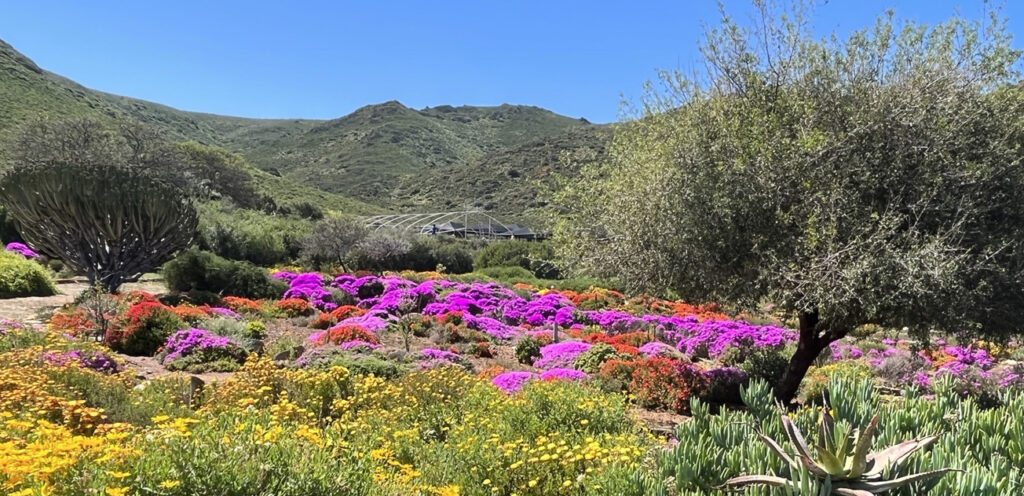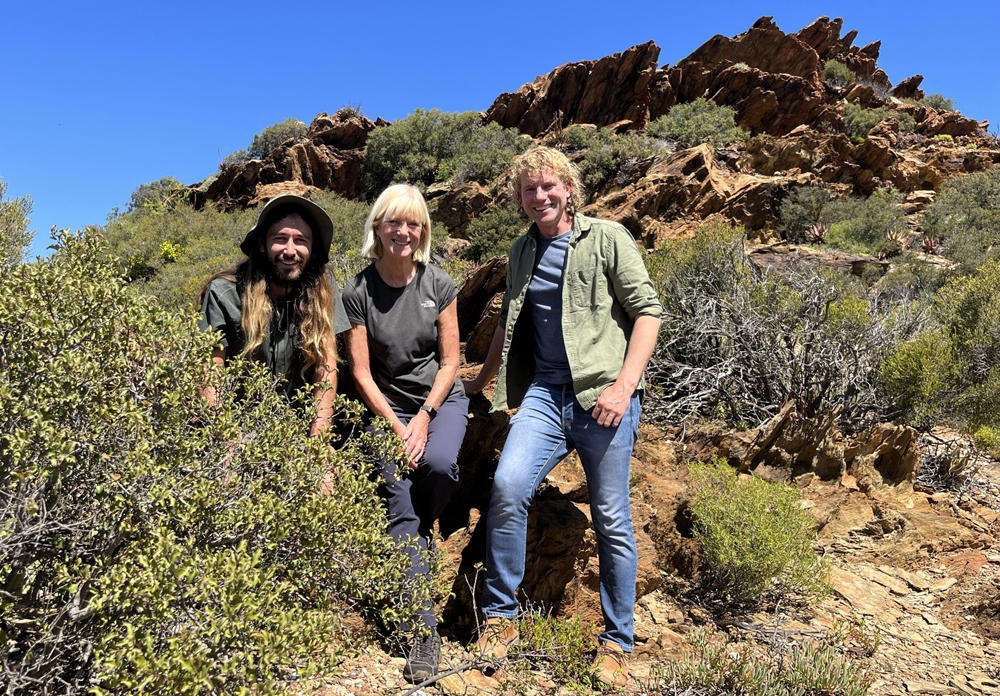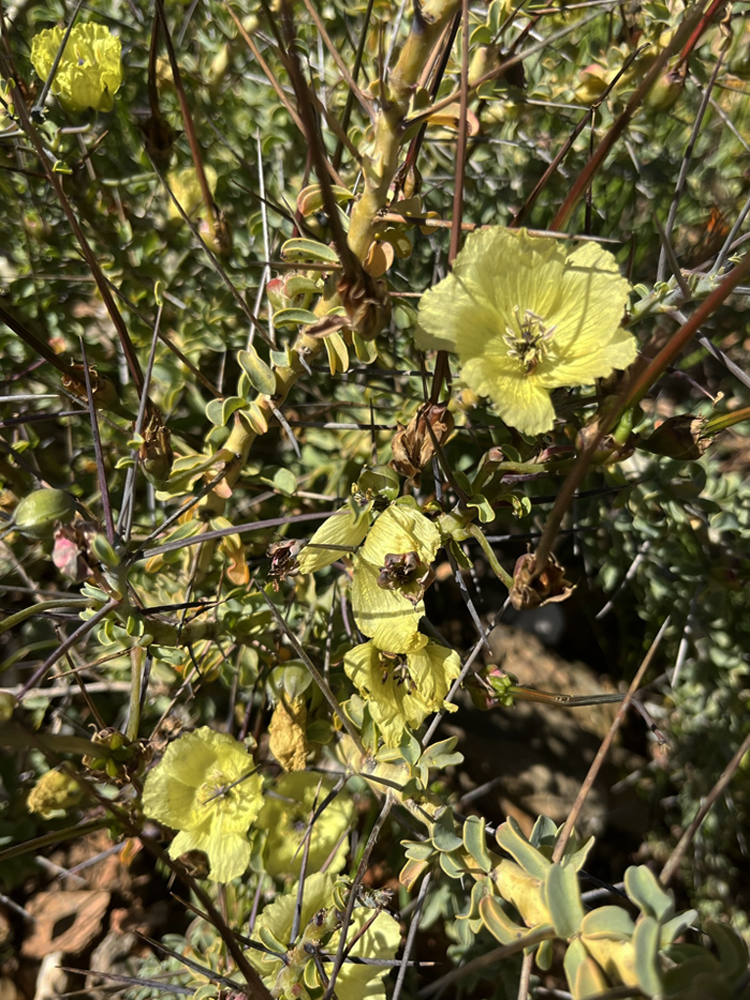Karoo Desert National Botanical Garden, S. Africa

120 km north-east of Cape Town, in a spectacular setting near the city of Worcester, lies the Karoo Desert National Botanical Garden. It comprises 154 hectares of semi-desert vegetation, 11 of which are cultivated, the rest being natural mountain side with rocky outcrops, covered in bushes and succulents.
À 120 km au nord-est du Cap, dans un cadre spectaculaire près de la ville de Worcester, se trouve le jardin botanique national du désert du Karoo. Il comprend 154 hectares de végétation semi-désertique, dont 11 sont cultivés, le reste étant naturel à flanc de montagne avec des affleurements rocheux, couverts d’arbustes et de plantes succulentes.
Opened in 1921, the garden was the second National Botanical Garden to be established after Kirstenbosch. In 1945, it was moved to the present site, with a number of the plants being relocated, Including several quiver trees, Aloe dichotoma, still surviving today.
Ouvert en 1921, le jardin était le deuxième jardin botanique national créé après Kirstenbosch. En 1945, il a été déplacé sur le site actuel, avec le déplacement d’un certain nombre de plantes, dont plusieurs arbres à carquois, Aloidendron dichotomum, qui survivent encore aujourd’hui.
We were very fortunate to be taken there by two knowledgeable locals, Leon Kluge, landscape designer, plantsman and writer, and Tristan Woudberg, artist and botanist. Arriving first in the ‘developed’ garden, the Day-Glo colours of the mesembryanthemums are startling, especially to a European eye. Mounds of bright pink, red and orange flowers carpet the ground.
Nous avons eu beaucoup de chance d’y être emmenés par deux locaux bien informés, Leon Kluge, paysagiste, planteur et écrivain, et Tristan Woudberg, artiste et botaniste. En arrivant d’abord dans le jardin « développé », les couleurs fluos des mésembryanthèmes sont surprenantes, surtout pour un œil européen. Des monticules de fleurs rose vif, rouges et orange tapissent le sol.

Whilst these mesembs had been planted, as we climbed higher up the ‘shale trail’, named after the Malmesbury shale which characterises the landscape, plants of the Mesembryanthemaceae family were growing in their natural habitat, alongside other plants with brightly coloured flowers such as gazanias.
Tandis que ces plantations de mésembryanthèmes nous accompagnaient, au fur et à mesure que nous montions plus haut sur le « sentier des schistes », du nom des schistes de Malmesbury qui caractérisent le paysage, poussaient dans leur habitat naturel des plantes de la famille des Mesembryanthemaceae, à côté d’autres plantes aux fleurs de couleurs vives comme les gazanias.

Leon and Tristan explained that the petals of the paler coloured mesembs were shiny in order to attract pollinating insects and that red flowers are attractive to the Mountain Pride butterfly (Aeropetes tulbaghia).
Léon et Tristan ont expliqué que les pétales des mésembryanthèmes de couleur plus pâle étaient brillants afin d’attirer les insectes pollinisateurs et que les fleurs rouges attiraient le papillon « Fierté de la montagne » (Aeropetes tulbaghia).
The rocky slopes were also home to a huge variety of succulent plants. Some, such as the haworthias, were to be found tucked under shrubs, known as ‘nurse’ plants as they provided protective shade for the smaller plants beneath. Other succulents, like Conophytum ficiforme, locally known as ‘baby’s toes’, were happy in full sun.
Les pentes rocheuses abritaient également une grande variété de plantes succulentes. Certaines, comme les haworthias, se trouvaient nichées sous des arbustes, connus sous le nom de plantes « nourrices », car elles fournissent une ombre protectrice aux petites plantes situées en dessous. D’autres plantes succulentes, comme Conophytum ficiforme, connue localement sous le nom de « orteils de bébé », se plaisaient en plein soleil.
Returning to the cultivated garden, Leon and Tristan introduced us to many plants that were new to us, some of which had intriguing local names due to the traditional uses of the plant. ‘Bushman’s candle’ (Monsonia spinosa) has developed thorns to protect it from being eaten and its waxy stems can be used as a bush firelighter. The hollowed-out stems of the tree aloe, Aloidendron dichotomum, or quiver tree, were used to make quivers to hold arrows. It was clear why Sansevieria cylindrica, a member of the Asparagaceae family, got its local name of elephant’s toothpick.
De retour au jardin cultivé, Léon et Tristan nous ont présenté de nombreuses plantes nouvelles pour nous, dont certaines portaient des noms locaux intrigants en raison des utilisations traditionnelles de la plante. La « Bougie du bushman » (Monsonia spinosa) a développé des épines pour la protéger contre la consommation et ses tiges cireuses peuvent être utilisées comme allume-feu de brousse. Les tiges évidées de l’aloès en arbre, Aloidendron dichotomum, ou arbre à carquois, étaient utilisées pour fabriquer des carquois afin de ranger les flèches. Pour une raison évidente, Sansevieria cylindrica, membre de la famille des Asparagacées, tire son nom local de cure-dent d’éléphant.
This was a great day out in a stunning location, with its interesting mix of botanical garden displaying southern African desert and semi-desert plants, and trails through the natural veld reserve with over 400 naturally occurring plant species. Thank you, Leon and Tristan for being wonderful guides.
Ce fut une excellente journée dans un endroit magnifique, avec son mélange intéressant de jardins botaniques présentant des plantes désertiques et semi-désertiques d’Afrique australe, et des sentiers à travers la réserve naturelle de Veld avec plus de 400 espèces de plantes naturelles. Merci Léon et Tristan d’avoir été de merveilleux guides.

Text and photos: Christine Daniels
Editor’s note:
Read more about the Gardens and Plants of the South African Cape in an article describing visits to 23 gardens in Cape Town and the winelands, and three botanical walks on the Cape Peninsula.Note de l’éditeur :
Apprenez-en davantage sur les jardins et les plantes du Cap sud-africain dans un article décrivant les visites de 23 jardins du Cap et des régions viticoles, ainsi que trois promenades botaniques sur la péninsule du Cap.
![]()









